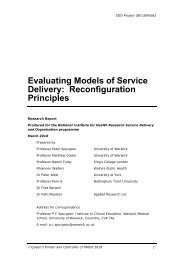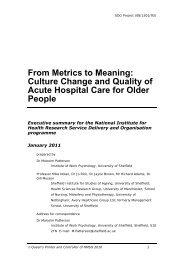Evaluation of IT modernisation in the NHS - NETSCC
Evaluation of IT modernisation in the NHS - NETSCC
Evaluation of IT modernisation in the NHS - NETSCC
You also want an ePaper? Increase the reach of your titles
YUMPU automatically turns print PDFs into web optimized ePapers that Google loves.
Report to SDO for NCRS ProjectReview <strong>of</strong> Economic Implications3. Systematic review <strong>of</strong> <strong>the</strong> economic implications <strong>of</strong> large scale <strong>IT</strong>implementation <strong>in</strong> health care3.1. IntroductionThe scarcity <strong>of</strong> available health care resources means that <strong>the</strong>y need to beallocated so that <strong>the</strong>y generate <strong>the</strong> maximum possible health benefit. The goal <strong>of</strong>economic evaluation is to provide a comprehensive assessment <strong>of</strong> potential costsand benefits to provide <strong>the</strong> necessary support <strong>in</strong> this decision mak<strong>in</strong>g process.Drummond et al. def<strong>in</strong>e economic evaluation as “<strong>the</strong> comparative analysis <strong>of</strong>alternative courses <strong>of</strong> action <strong>in</strong> terms <strong>of</strong> both costs and consequences”. 46 Acomprehensive economic evaluation should conta<strong>in</strong> a number <strong>of</strong> key elements.These <strong>in</strong>clude <strong>the</strong> identification, measurement, valuation and comparison <strong>of</strong> allrelevant costs and consequences relat<strong>in</strong>g to <strong>the</strong> alternative technologies underconsideration. A competent economic evaluation will also assess <strong>the</strong> level <strong>of</strong>uncerta<strong>in</strong>ty surround<strong>in</strong>g <strong>the</strong>se results so that <strong>the</strong> decision-maker can assess <strong>the</strong>robustness <strong>of</strong> <strong>the</strong> results with respect to alternative assumptions. 47In <strong>the</strong>ory, all health care technologies should be subject to economic analysis.However, <strong>the</strong> need for robust and comprehensive economic evaluations becomeseven greater when <strong>the</strong> implementation <strong>of</strong> particularly costly technologies is be<strong>in</strong>gdebated. The current National Programme for <strong>IT</strong> (NPf<strong>IT</strong>) for <strong>the</strong> <strong>NHS</strong>, with anestimated <strong>in</strong>vestment outlay <strong>of</strong> £6.2 billion over ten years, certa<strong>in</strong>ly satisfies thiscriterion. 483.2. Background <strong>in</strong>formation on <strong>IT</strong> implementationThe economic implications <strong>of</strong> <strong>the</strong> <strong>in</strong>tegration <strong>of</strong> <strong>in</strong>formation technology (<strong>IT</strong>) <strong>in</strong>tohealth care and its consequences have been studied widely. Although <strong>the</strong>amount <strong>of</strong> literature on this subject is vast, it is difficult to f<strong>in</strong>d a consensus amongresearchers on <strong>the</strong> methods <strong>of</strong> evaluation and <strong>the</strong> effects <strong>of</strong> <strong>the</strong> implementedtechnology.The majority <strong>of</strong> <strong>the</strong> studies <strong>in</strong> this review compared <strong>the</strong> impact <strong>of</strong> an <strong>IT</strong><strong>in</strong>tervention, by study<strong>in</strong>g various outcome measures (e.g. costs, time saved,change <strong>in</strong> productivity) before and after <strong>in</strong>troduction <strong>of</strong> <strong>the</strong> <strong>in</strong>tervention. A small24
















